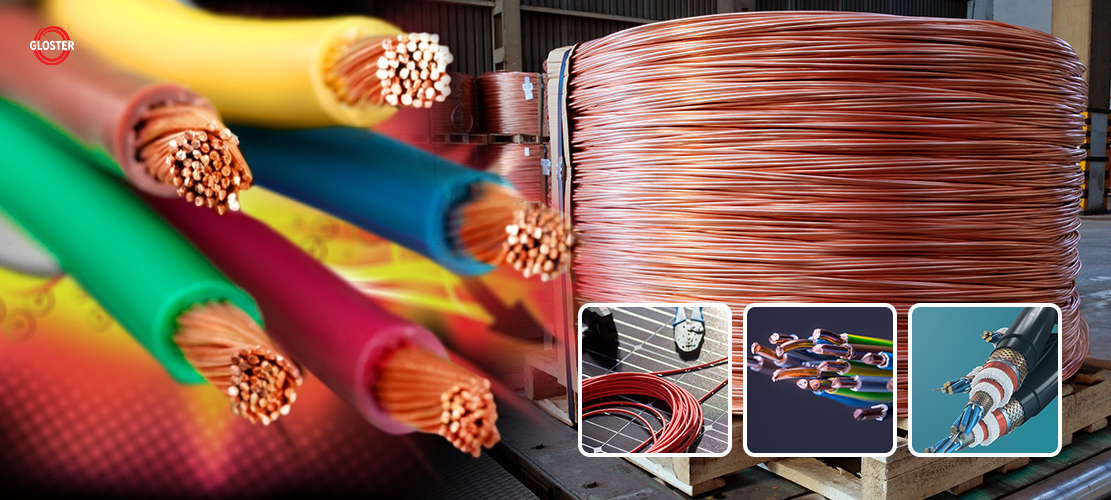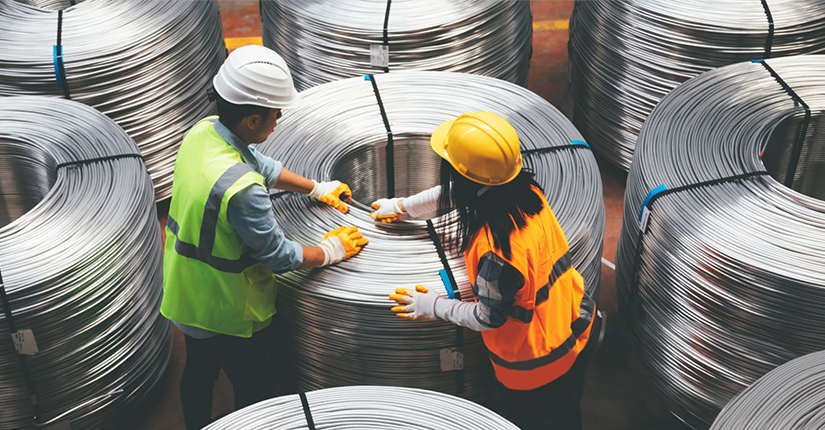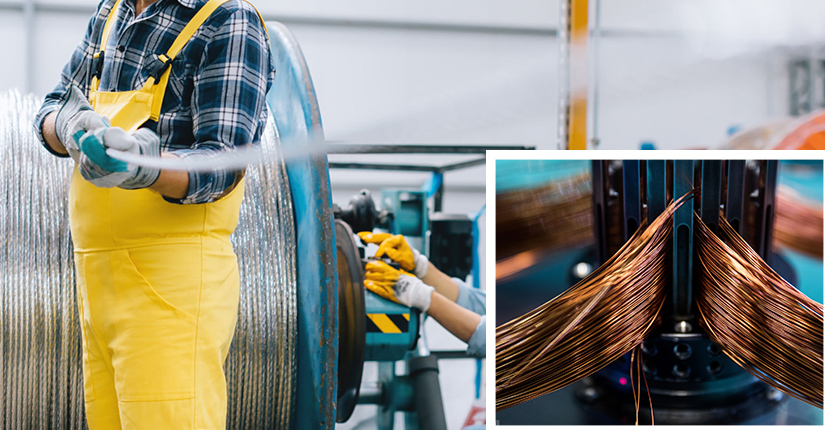
Standardization and Manufacturing of Industry Grade Wires and Cables
Wires and cables come in different types, sizes, colors, and applications to meet residential, commercial, and industrial purposes. Industrial grade wires and cables designed for high electric transmission need to operate and endure industrial stress because of physical, environmental, electrical, and other factory hazards.
Gloster Cables is a leading manufacturer of industrial wires and cables serving the industry with high-quality and durable products. The industrial wires and cables manufactured at Gloster follow international manufacturing standards and safety standards to survive even in the harshest industrial conditions.
Gloster offers a range of industrial-grade wires and cables for different industrial applications. It includes low and high-voltage cables, heat-resistant cables, fire survival cables, RTD cables, etc. All the products are tested to meet and pass through several industrial challenges as part of the company’s research, innovation, and manufacturing process.
How Industry Grade Wires and Cables are Different
Each industrial unit or plant requires a different set of wires and cables. So that they perform when exposed to the environment such as heat, electricity, corrosive chemicals, and abrasive elements. The mechanical and chemical properties of cable sheathings play a vital role in their survival.
Cables with PVC sheathing are suitable for areas subjected to moderate mechanical stress, like the food industry. They also offer good resistance to chemical agents. PUR sheathed cables provide long-lasting flexibility and high mechanical strength required for plant engineering, assembly lines, and production lines. PUR A is also suitable for manufacturing plants because of its flame retardant properties. Similarly, the automotive industry prefers PUV A and POC sheathed cables due to their high mechanical strength and thermal resistance.
Present different grades of wires used for industrial use are 250/440 volts and 650/1100 volts. 250/440 volts grade cables are preferable when DC supply voltage does not exceed 250 volts, or a.c supply line voltage is not more than 415 volts. Whereas a 650/1100 volts grade cable is suitable when the circuit voltage exceeds 415 volts, the pressure between the line conductor and earth does not exceed 650 volts.
Manufacturing Process and Quality Standards Followed by Industrial Grade Wires
There are numerous industrial wires and cables based on their application and usage. And manufacturing process of these wires is complex and tedious to make them durable and function under extreme operating environments. The main stages involved in the wire manufacturing process are drawing, annealing, wiring, hot extrusion, voltage testing, phase wiring, and additional protection.

Drawing
The wire drawing is a metalworking process where the wire gets pulled through a single drawing die or multiple to reduce the cross-section of the wire. The process is performed at room temperature, known as a cold working process or an elevated temperature for large wires. Commercial wire drawing commences from the hot-rolled coil of 9 mm diameter.
Wire Annealing
Annealing is heat treating the wire to improve its physical properties such as ductility and conductivity. The two methods of annealing are batch annealing and strand annealing.
In Batch annealing, wire is placed in a large furnace and shield placed over the wire, and hydrogen replaces air. Then, an electric heat jacket is placed above the shield at a proper time length to clean and soften the metal.
And in the second method, the wire is pulled through tubes filled with hydrogen in a Strand Annealing Furnace. Here, the heat may rise to 2,300-degree Fahrenheit, unlike batch annealing.
Wire Twisting and Stranding
After annealing, the wires of the same cross-sectional area get stranded or twisted with a proprietary formula that helps identify the twist length. Twisting and stranding help improve the electrical performance and flexibility of the conductor.
Extrusion
Now, the wire becomes soft and flexible and passes through an extruder. We apply a plastic coating or any insulating material based upon the wiring requirement, capacity, and thermal resistance. Higher the insulation thickness and capacity higher will be the maximum surface voltage of the wire.
Voltage Testing and Phase Wiring
Voltage testing helps ensure the insulation has no current leakage and is fault-free. In the case of multi-core wire processing, different phases are marked with different colors, numbers, etc., to differentiate them from each other.
Cabling
Next, the formed cable is assembled in a cabling station based on different utilities. Electrical and electronics cables are wrapped with an interference preventing layer or into a protection jacket as required. Fillers help give a round shape to the cable. Power cables or others buried underground have more protective layers, like inner sheath, armor, and outer sheath.
International Standards Followed by Gloster
Many Industries require industrial-grade wires and cables to follow international standards and regulations. Our products comply with specific standards and regulations, like ISO 9001:2015, CE mark, Compliance Safety Accountability, Lead-free, National electric code, etc. Some industrial grade wires that comply with specific international standards are:


Manufacturing Process to Ensure the Wires and Cables Standards
In order to achieve these international standards products, Gloster adopts standard measures in their manufacturing process.

 Online wire drawing and annealing
Online wire drawing and annealing
Gloster uses fine wire drawing machines with online annealing, especially for copper wire 0.4-1.6mm from 2.6-3mm.
 High-speed Extruders
High-speed Extruders
The use of high-speed extruders improves electrical efficiency, improves polymer properties, reduces purging, and changes over time.
 Rigid QC process
Rigid QC process
We follow a rigid QC process to overcome any flaw and meet the international quality standard for our products.
 Zero halogen flame retardant
Zero halogen flame retardant
ZHFR wires are insulated up to 16 sq. mm, for better insulation and electrical properties.
 Automatic diameter control
Automatic diameter control
Automatic diameter control helps in the accuracy and precision of wires and cables.
Best Practices to Ensure Industrial Electrical Safety
Industries and factories need to adopt and comply with set standards and measure to avoid electrical hazards and ensure electrical safety. Monitor the electrical equipment regularly to ensure they are working accordingly. And are fully grounded and ideally double-insulated if required. Inspection and testing of the following industrial electrical equipment can avoid potential electrical hazard risks.

 Follow OSHA for electrical wiring
Follow OSHA for electrical wiring
Industries must follow OSHA for electrical wiring and general electrical requirements to avoid electrical injuries.
 Cables, sockets, plugs, and cords
Cables, sockets, plugs, and cords
These types of equipment should be accurately insulated and should have the required electrical capacity for usage.
 Fuse box and insulators
Fuse box and insulators
Close and lock the fuse box and insulators appropriately to avoid any mishap.
 Check on electrical equipment, and overhead power lines
Check on electrical equipment, and overhead power lines
Electrical equipment and overhead power lines should only get operated by professionals.
 Identify electric shock and arc flash hazard
Identify electric shock and arc flash hazard
Any electric shock or arc flash hazard, if identified, should be immediately rectified to avoid any further accidents.
Contribution of Gloster Towards Industry-grade Wires and Cables
Gloster Cables withstand excellence for more than 25 years in electrical wires and cable manufacturing for residential, industrial, and commercial purposes. Being an ISO: 9001:2015 certified company, Gloster follows a stringent QC plan at all stages of its manufacturing process. The products like instrumentation cables, solar cables, Fire survival cables, etc., are U/L certified and approved by CPRI, ERDA, ETDC, and TUV international testing laboratories.Check our wires and cables product portfolio and contact for a custom quote.
CONTACT US